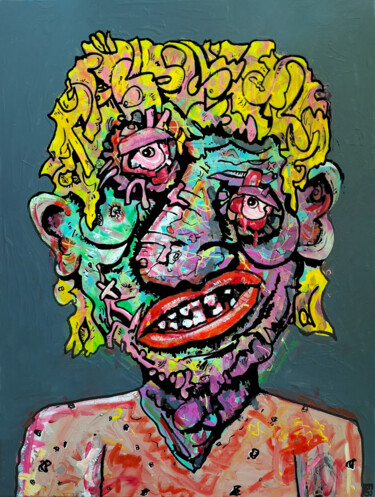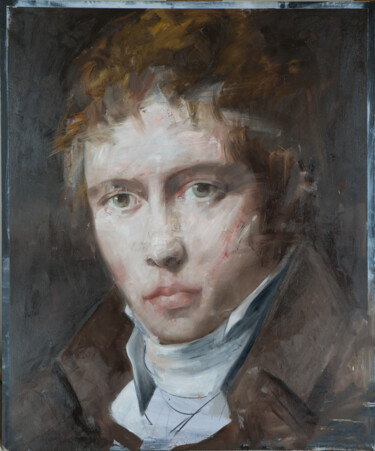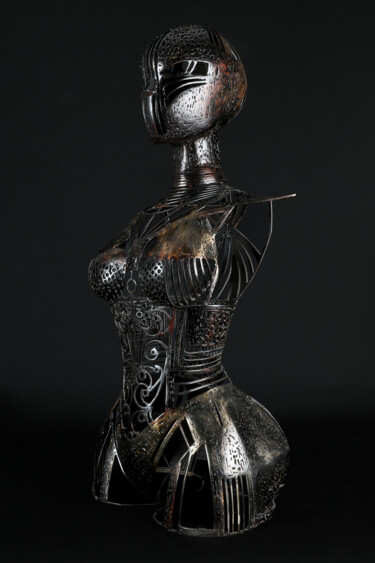 Mahé, At the hours when bodies are pierced by light, 2022. Oil on canvas, 40 x 40 cm.
Mahé, At the hours when bodies are pierced by light, 2022. Oil on canvas, 40 x 40 cm.
Busts: Roman art and Modigliani compared
In order to understand the peculiarities of the bust, a representative genre that is predominantly sculptural, but also pictorial and photographic, a direct approach to the subject, aimed at involving the reader in the analysis of a concrete example of the aforementioned portrait typology, is extremely effective, as well as more stimulating and engaging. Therefore, I bring as an example a well-known masterpiece preserved in the Capitoline Museums of the "Eternal City," namely the Capitoline Brutus, a bronze bust with ivory eyes and glass paste that, discovered in Rome during the 16th century, was already at that time identified as the depiction of Lucius Junius Brutus, the mythical founder of the Roman Republic, as well as the ancestor of Marcus Junius Brutus, that is, the murderer of Julius Caesar. According to the most reliable sources, this sculpture was bequeathed to the capital of Italy by Rodolfo Pio da Carpi, an Italian scholar and collector who had built up a rich collection of ancient artifacts in the 16th century. Later, the Capitoline Brutus left Rome for the Ville Lumière, a city he reached during the Napoleonic campaign of the late 18th century, a period when General Bonaparte used the cultural and political meanings associated with ancient Roman art to reinforce his image as a European leader. In fact, the very sculpture mentioned was part of the triumphal parade in Paris, an event organized by Napoleon after his invasion of northern Italy, during which the spoils of art were put on display to the tune of a song expressing decidedly imperialistic concepts such as "Rome is no longer Rome. Now it is in Paris." Fortunately, the work was returned to Rome around 1814, that is, after the defeat of Napoleon and the prodigious intervention of Antonio Canova, one of the most famous Italian artists of the time, who was invested by Pope Pius VII with the task of recovering the looted masterpieces in the cultural centers of the Papal States.
 Bruto capitolino (bust with additions), c. 300-275 BC. Bronze. Rome: Capitoline Museums.
Bruto capitolino (bust with additions), c. 300-275 BC. Bronze. Rome: Capitoline Museums.
 Amedeo Modigliani, Bust of young woman, 1911. Oil on canvas, 55 x 38 cm.
Amedeo Modigliani, Bust of young woman, 1911. Oil on canvas, 55 x 38 cm.
Returning to the bust, the realistic portrayal of the character indicates, in addition to accurate physiognomic refinement, a strong desire to express the effigyed's psychological connotations, such as gravitas and the typical tension of the Roman patrician. Moreover, it is precisely this interest in the most meticulous rendering of the real datum, accompanied by a strong attention to detail, that decisively relates the masterpiece to Hellenistic portraiture of the early third century BCE. Therefore, the Capitoline Brutus could date from the latter period, a time of great cultural and political expansion in Roman history. The genre of the bust, however, did not end with ancient art, so much so that it is possible to compare, albeit somewhat daring, the Roman realistic style and compositional balance with an extremely personal, elongated and stylized point of view, namely that of Amedeo Modigliani, a florid interpreter of the aforementioned type of portrait, which he analyzed in masterpieces such as Red Bust (1913), Bust of a Woman (c. 1906-19), Bust of a Nude Woman (1907) and Bust of a Young Woman (1911). Regarding the latter painting, the work most likely depicts an intense portrait of Russian poetess Anna Achmatova, wife of the man of letters Nikolai Stepanovič Gumilëv and a great friend of the Leghorn painter, who portrayed her on several occasions. Regarding the style of the bust, the figure portrayed, unlike that of Brutus, is rendered through an interesting geometric interlocking, represented by the superimposition of the cylindrical neck on the oval-shaped head, surmounted by a hairstyle highly reminiscent of the ancient world. In addition, the manner of execution of the eyes, concealed by the extension of a dark hue, hints at a distinctive feature of Modigliani's anatomical investigation, intended to allude to his refusal to paint the pupils of characters whose souls the artist did not know. Consequently, the theme of "blindness" separates the ancient world from the modern one, in which man, realizing his own complexity, can also refuse to conceive of realist representation as an exhaustive explication of his being.
 Tetiana Bogdanova, Blueberry pancakes, 2020. Oil on canvas, 60 x 40 cm.
Tetiana Bogdanova, Blueberry pancakes, 2020. Oil on canvas, 60 x 40 cm.
 Bogdan Dide, Luna, 2022. Acrylic / oil on linen canvas, 92 x 73 cm.
Bogdan Dide, Luna, 2022. Acrylic / oil on linen canvas, 92 x 73 cm.
The genre of the bust: some notions
Coming finally to the most classic definitions, the bust is a sculptural, pictorial or photographic representation of the upper part of the human figure, aimed at reproducing the head and neck, but also the chest, shoulders and, in rarer cases, the hands and arms. In particular, when the upper part of the chest is also included in the work, it is specifically named half-bust, while if the sculpture includes only the head, it is called a head. Although the bust originated in Hellenistic Greece and reached its greatest popularity in the ancient Roman world, it has undergone interpretative variations over the centuries, re-presenting itself even in contemporary times, a period in which, thanks to the most modern technologies, it has also taken shape in a 3-D version. The modern cult of busts can also be found in Artmajeur's rich collection of sculptural works, exemplified by the artistic investigation of Katerina Pilnikova, Priscilla Vettese and Cécile Duchêne Malissin.
 Katerina Pilnikova, Overjoyed ceramic, 2018. Ceramic sculpture, 26 x 21 x 10 / 2.50 kg.
Katerina Pilnikova, Overjoyed ceramic, 2018. Ceramic sculpture, 26 x 21 x 10 / 2.50 kg.
Katerina Pilnikova: Overjoyed ceramic
Referring to Pilnikova's words, Overjoyed ceramic depicts a young man in a state of euphoria, a phrase that obligatorily refers us to the principle expounded by a controversial contemporary artist, namely Jeff Koons, who firmly argues that the true value of art is "emotional" rather than monetary, that is, inherent in that ability to convey healthy optimism. Certainly, the Artmajeur artist's joyful work fulfills that requirement, which, indelibly linked to the positive message delivered by the protagonist's attitude, could be traced to the same sentiment aimed at animating Bourgeois Bust, a Neo-pop sculpture by the aforementioned Koons. Indeed, the latter 1991 bust, which depicts the same artist in the company of his ex-wife Ilona Staller, was created by the master for the Made in Heaven exhibition, an event that explored the concept of love, a feeling often responsible for the highest states of euphoria. Therefore, it is possible to imagine the effiged of Overjoyed ceramic as a veteran of an amorous encounter in the style of Bourgeois Bust, that is, charged with such erotic tension as to leave marks in retrospect, allowing one to experience that joy and satisfaction, which often only falling in love grants to humankind.
 Priscilla Vettese, Sculpture of Diana Pop, 2022. Sculpture, spray paint / acrylic / marker / stencil / resin on other support, 30 x 16 x 11 cm / 3000.00 g.
Priscilla Vettese, Sculpture of Diana Pop, 2022. Sculpture, spray paint / acrylic / marker / stencil / resin on other support, 30 x 16 x 11 cm / 3000.00 g.
Priscilla Vettese: Sculpture of Diana Pop
Priscilla Vettese's Pop work represents an unprecedented and original reinterpretation, made in the "format" of a bust, of the iconic Louvre sculpture entitled the Diana of Versailles, a Roman marble copy of the 1st-2nd century AD, executed from a Greek bronze original attributed to Leocare (c. 325 BC.). That marble masterpiece, probably discovered in Tivoli, Italy, is now in the Paris museum, as it was donated by Pope Paul IV to King Henry II of France in 1556. The latter initially exhibited the work in the castle of Fontainebleau and later at the Louvre, a museum to which the marble returned after a brief interlude spent in the Palace of Versailles, a location from which it probably inherited part of its name. Regarding the sculpture's description, The Diana of Versailles depicts the goddess of hunting standing, looking fiercely to the right, concentrating on observing the arrow drawn from her quiver, while her left hand holds a now incomplete bow placed above a roe deer immortalized in the act of running. Compared to this strongly narrative image, the Artmajeur artist's work turns out to be more concise and immediate, as it pursues the goal of transforming the masterpiece into a kind of media celebrity, having as its figurative conformation a format that is more easily reproduced, multiplied and, consequently, marketable and "venerable" by the masses.
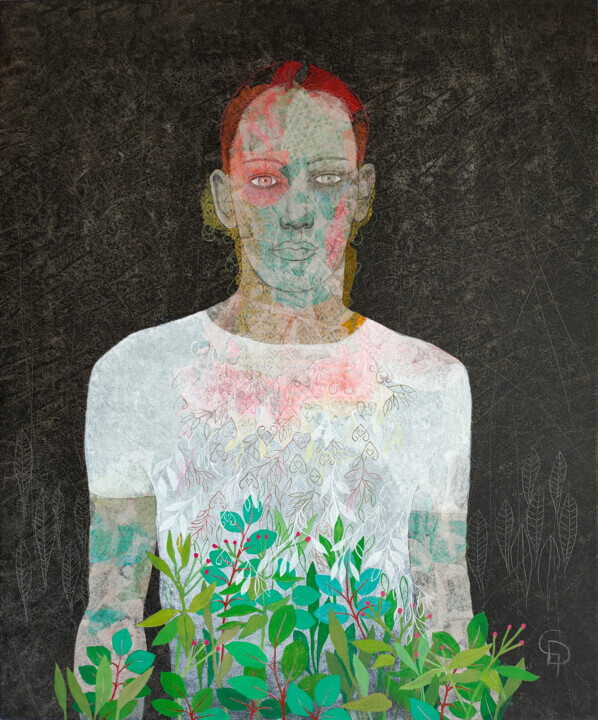 Cécile Duchêne Malissin, Fragile Souvenir XI, 2022. Acrylic on canvas, 65 x 54 cm.
Cécile Duchêne Malissin, Fragile Souvenir XI, 2022. Acrylic on canvas, 65 x 54 cm.
Cécile Duchêne Malissin: Fragile Souvenir XI
Fragile Souvenir XI is a portrait aimed at synthesizing a borderline case of the torso genre because, in addition to portraying the hands and arms, it also gives a glimpse of parts of the hips, which, however, remain cleverly concealed by the flourishing vegetation. The close relationship between the work's protagonist and nature, depicted as a kind of fusion between the two essences, brings to mind a masterpiece in which the same symbiosis is realized, namely Giuseppe Arcimboldo's Vertumno (1590). Speaking of the Italian painting, Arcimboldo created the work when he returned to his native Milan, that is, after spending a good twenty-five years at the Habsburg court. Despite this move, the artist remained in the service of Rudolph II, whom he depicted precisely in the guise of Vertumno, a god of the seasons aimed at bringing together the fruits and vegetables of all periods of the year, previously collected in the works of The Four Seasons. Precisely in keeping with the style of the latters: the nose of Rudolf II is made into a pear, the cheeks are two enormous peaches, and the hair is a mix of fruit and ears of gilt. Finally, such a work, just like Summer, Autumn, Winter and Spring, pursues the intent of celebrating the power of the Habsburg house, representing its dominance not only over rival families, but over all of creation, including fruits and vegetables. Consequently, the Artmajer artist's work could also allude to the sovereignty exercised by man over nature, depicted at the lower end of the effigy's body.

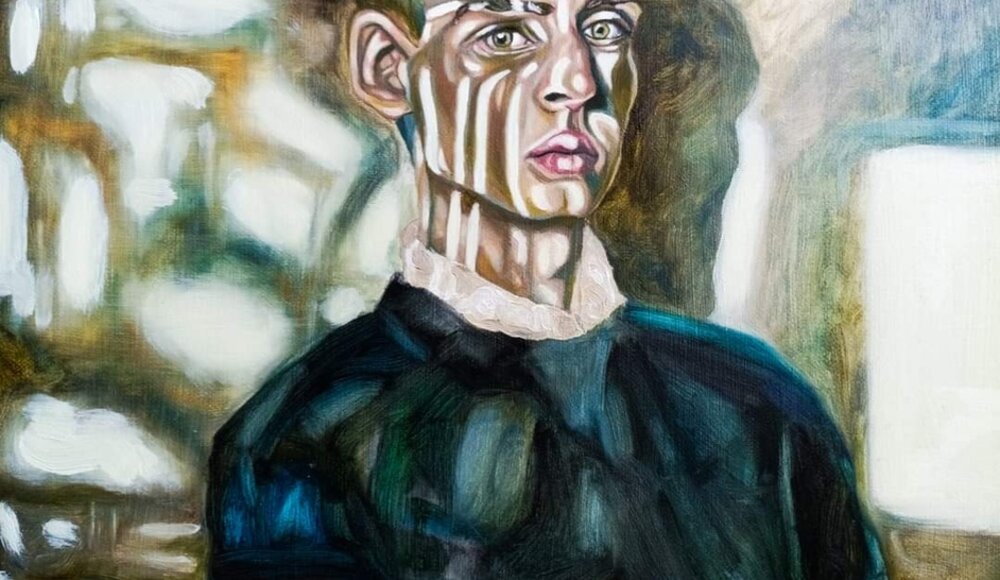
 Olimpia Gaia Martinelli
Olimpia Gaia Martinelli



